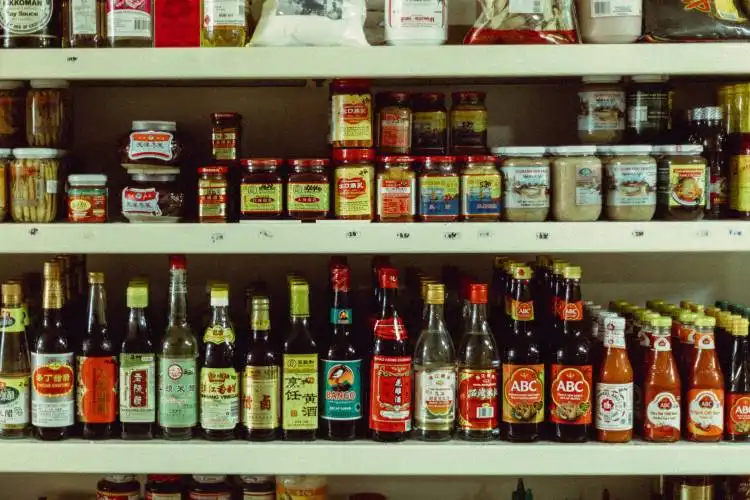Start an International Food Store
Embark on a Culinary World Tour with Your Startup
| Updated


INTERNATIONAL FOOD STORE
Travel the world without ever leaving home with an international food store startup! This excellent business idea revolves around offering eclectic food items from various cultures worldwide. It bridges the taste gap, by bringing foreign cuisine right to our doorsteps or local blocks. Whether it’s hard-to-find Asian spices, European cheese varieties, or South American fruits, your business creates a world tour for the tastebuds, providing a unique blend of culinary adventure to cuisine enthusiasts and home cooks alike.
Jump to Business Plan
RELATED BUSINESS IDEAS
Browse ALL Food & Beverage Entrepreneurship Business Ideas
Discover Your Perfect Domain
Unlock the door to your online success with our hand-picked selection of premium domain names. Whether you're starting a new venture or rebranding an existing one, the right domain can set the tone for your digital presence. Browse through our curated list, each with its unique potential to enhance your brand's visibility and credibility.
INTERNATIONAL FOOD STORE MINI BUSINESS PLAN
This a quick reality check to help you identify the strengths and weaknesses of your business concept before you dive in.
Business Idea: International Food Store
Expected Percent Margins:
- Gross Margin: 30-40%
- Net Profit Margin: 5-10%
Earnings Expectations:
- Daily Earnings: $300 - $600
- Weekly Earnings: $2,100 - $4,200
- Monthly Earnings: $9,000 - $18,000
- Annual Earnings: $108,000 - $216,000
Actions to Hit Those Numbers:
Inventory Management:
- Initial Investment: At least $30,000-$60,000 for a diverse product offering from different countries.
- Supplier Network: Develop relationships with companies that import international food products.
Marketing and Customer Acquisition:
- Social Media: Share posts about unique products and their origins 3-5 times a week on Instagram, Facebook, and even YouTube for tutorials.
- Local Advertising: Engage in partnerships with local multicultural societies and community events.
Sales and Customer Experience:
- Staffing: Employ a multilingual and culturally diverse staff capable of explaining unique items to customers.
- Product Knowledge: Train staff extensively on the products you sell to provide knowledgeable customer support and get customers excited about trying new things.
Cost Control:
- Rent: Opt for a location in a multicultural neighborhood or near university campuses, where rent is less than 10% of expected monthly sales.
- Utilities and Maintenance: Budget around $500-$1000 per month.
Business Operations:
- Open Hours: Be Open at least 6 days a week, 10 hours a day to accommodate varying customer schedules.
- Transaction Volume: Aim for 20-40 transactions per day at an average sale price of $20-$30.
Remember, these numbers can vary widely depending on location, competition, and other business specifics. Always working with a financial advisor to ensure a good business plan is wise.
NOT WHAT YOU HAD IN MIND? Here are more ideas



Browse ALL Food & Beverage Entrepreneurship Business Ideas
Grab Your Business Website Name
Before you get caught up in the whirlwind of setting up your business, invest in a domain name. It's a small but significant step that lays the foundation for your brand and makes it easier for customers to find and trust you. Just like you wouldn't build a house without securing the land first, don't build a business without securing your domain name.
"Why? Can't that wait?" Here's why it shouldn't
Step 1: Determine if the Business is Right Endeavor
Breakdown of Startup Expenses
When starting an international food store, it is important to understand the startup costs associated with the business. This includes the cost of the physical space, such as rent, utilities, and other expenses associated with the space. Additionally, the cost of equipment, such as refrigerators, shelving, and other necessary items, should be taken into account. The cost of inventory, such as food, drinks, and other items, should also be taken into account. Finally, the cost of marketing, such as advertising, should be included in the startup expenses.
Breakdown of Ongoing Expenses
Once the business is up and running, there are ongoing expenses that should be taken into account. This includes the cost of labor, such as wages, benefits, and other expenses associated with employees. Additionally, the cost of inventory, such as food, drinks, and other items, should be taken into account. The cost of utilities, such as electricity, water, and other necessary items, should also be taken into account. Finally, the cost of marketing, such as advertising, should be included in the ongoing expenses.
Examples of Ways to Make Money
When starting an international food store, it is important to understand how to make money. This includes the sale of food, drinks, and other items. Additionally, the sale of merchandise, such as t-shirts, hats, and other items, should be taken into account. The sale of services, such as catering, should also be taken into account. Finally, the sale of gift cards, coupons, and other promotional items should be included in the ways to make money.
Step 2: Name the Business
When it comes to naming your international food store, it is important to consider the type of food you plan to sell and the target audience. You should also consider the location of the store and the type of customers you plan to attract. Additionally, you should think about the branding of the store and the message you want to convey to potential customers. It is important to choose a name that is unique, memorable, and easy to pronounce. You should also consider the domain name availability for the store and whether or not the name is trademarked. Finally, you should also consider the language of the name and whether or not it will be easily understood by customers in different countries.
Once you have narrowed down your list of potential names, you should research the competition to ensure that your name is not too similar to another business. Additionally, you should research the meaning of the name to ensure that it does not have any negative connotations in different cultures. You should also consider how the name will look on signage, business cards, and other marketing materials. Finally, you should also consider how the name will look when it is typed into a search engine or when it is spoken aloud.
Step 3: Obtain a Business License
The third step in starting an international food store is to obtain a business license. Depending on the country and state, the process for obtaining a business license can vary. It is important to research the specific requirements for the area in which the store will be located. Generally, the process will involve filling out an application, providing proof of identity, and paying a fee. Additionally, it may be necessary to obtain a special permit or license to sell food products. It is also important to consider any zoning restrictions that may apply to the business. For example, some areas may require a certain distance between food stores, or may not allow certain types of food stores. Once all the necessary paperwork is filed and the fees are paid, the business license should be issued. With the license in hand, the business can then move forward with the next steps in the process.
Step 4: Find a Suitable Location
Finding a suitable location for an international food store is essential to the success of the business. The location should be in an area with a high population of people who are interested in international cuisine. It should also be accessible to customers, with plenty of parking and easy access to public transportation. Additionally, the store should be in a safe and secure area with minimal crime. It should also be near other businesses that could potentially draw customers to the store. Furthermore, the store should have enough space to accommodate the necessary equipment, shelves, and other fixtures. Finally, the store should be in an area with a reasonable rent that fits within the budget of the business.
Step 5: Design the Store
Designing the store is an important step in starting an international food store. It is important to create a space that is inviting and comfortable for customers. This includes choosing the right layout, furniture, and decorations. Consider the type of atmosphere you want to create and the type of customers you want to attract. Make sure to include enough space for customers to move around and browse the items. Additionally, consider the lighting and temperature of the store. The right design can help create a pleasant shopping experience for customers.
When designing the store, it is important to think about the type of products you will be selling. Consider the types of shelves, displays, and other fixtures you will need to properly showcase the items. Additionally, think about the type of checkout system you will need. Consider the type of payment methods you will accept and the type of technology you will need to process transactions. Finally, consider the type of signage you will need to help customers find the items they are looking for.
Step 6: Stock the Store
Now that the store is ready to open, it is time to stock the shelves. This is an important step as it will determine the success of the store. It is important to research the local market and understand the needs and wants of the customers. It is also important to research the international market and find suppliers that can provide the best quality and variety of products. It is important to find suppliers that can provide the products at competitive prices. Additionally, it is important to find suppliers that can provide the products in a timely manner. It is also important to find suppliers that can provide the products in the desired quantity. Finally, it is important to find suppliers that can provide the products in the desired packaging. Once the suppliers have been identified, it is important to negotiate the best possible terms and prices. Once the terms and prices have been agreed upon, it is time to order the products and begin stocking the store.
Step 7: Advertise the Store
Advertising the store is an important step in getting customers to come in and shop. There are a variety of ways to advertise an international food store. One of the most effective ways is to use social media. Creating a Facebook page, Twitter account, and Instagram account can help spread the word about the store and its offerings. Additionally, creating a website can help customers find the store and learn more about what it offers. Utilizing local newspapers, radio, and television stations can also be effective in advertising the store. Flyers and posters can be distributed in the local area to let people know about the store. Finally, word-of-mouth is a great way to advertise the store. Encouraging customers to tell their friends and family about the store can help increase the store’s customer base.
Step 8: Hire Employees
Hiring employees is an important step in starting an international food store. It is important to find employees who are knowledgeable about the food items being sold and who are passionate about the business. It is also important to find employees who are reliable and trustworthy. When hiring, it is important to check references and to make sure the employees have the necessary skills and qualifications. Additionally, it is important to create a job description that outlines the duties and responsibilities of the employee. It is also important to create a salary structure that is fair and competitive. Finally, it is important to provide training and development opportunities for employees to ensure that they are able to perform their duties effectively.
Step 9: Monitor the Business and Make Adjustments
The ninth and final step in starting an international food store is to monitor the business and make adjustments as needed. This is an important step to ensure that the business is running smoothly and is profitable. It is also important to keep up with the latest trends in the industry, such as new products, new technologies, and changes in customer preferences.
To monitor the business, it is important to keep track of sales, expenses, and profits. This can be done by creating a spreadsheet that includes all of the necessary information. It is also important to review customer feedback and make adjustments to the store as needed. This could include changing the product selection, changing the layout of the store, or adding new services.
It is also important to keep up with the competition. This can be done by researching other stores in the area and seeing what they are doing differently. This can give insight into what changes may need to be made to the store in order to remain competitive.
Finally, it is important to stay up to date with the latest trends in the industry. This can include attending trade shows, reading industry publications, and joining industry associations. By staying informed, it is possible to stay ahead of the competition and make sure the store is successful.
EXPLORE MORE CATEGORIES
Browse ALL Business Idea Categories
TAKE THE NEXT STEPS









